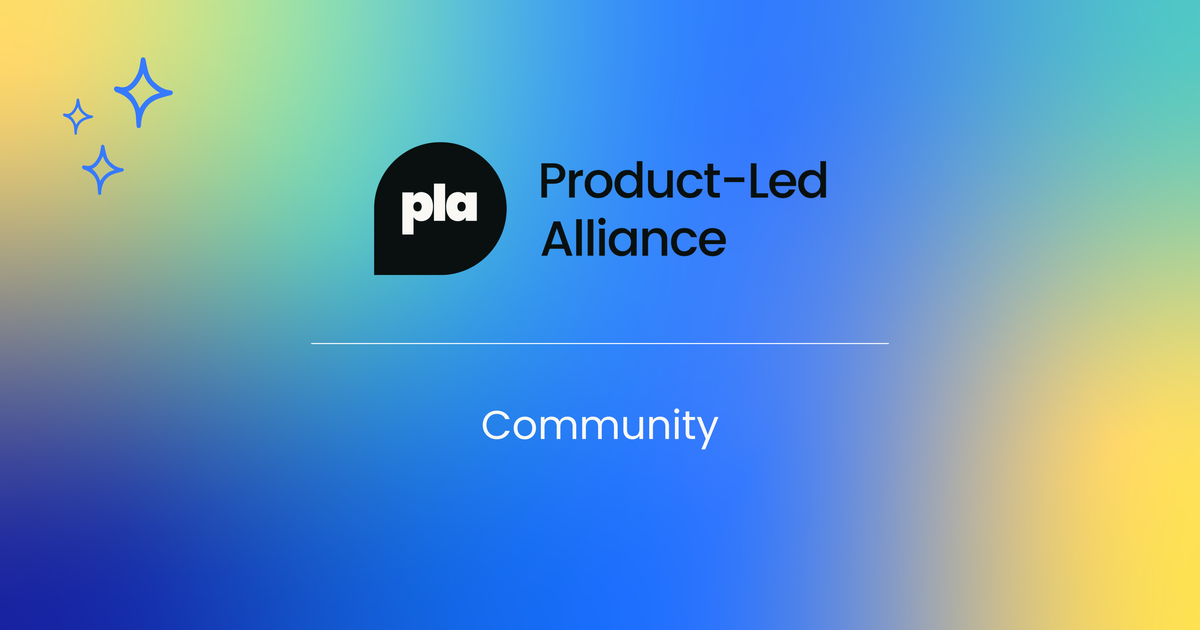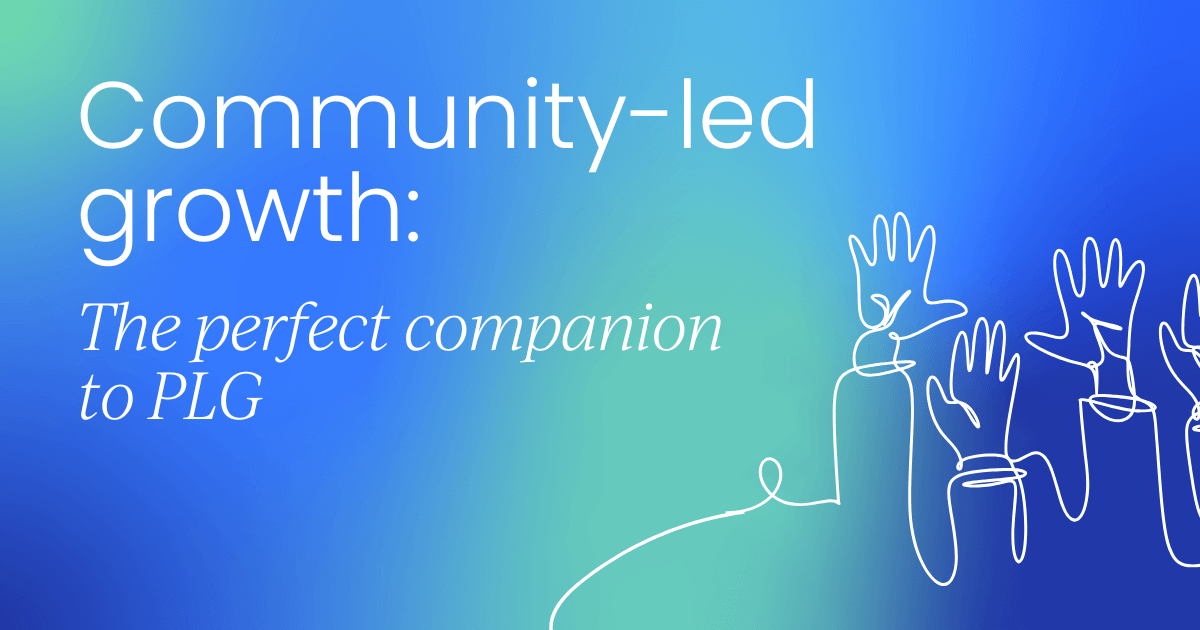There’s a rising star making waves in PLG: community-led growth. This strategy is quickly becoming a vital component of the PLG playbook, providing companies with an organic growth engine fueled by user-driven content, advocacy, and engagement. So let’s dive into the concept of community-led growth, how it complements PLG, and why it’s poised to play a significant role in the future of customer acquisition and retention.
What is community-led growth?
Community-led growth (CLG) is a business strategy that leverages a company’s user base to foster engagement, build advocacy, and drive organic customer acquisition. It places users at the heart of the growth strategy, creating spaces—whether digital or physical—where they can share knowledge, experiences, and feedback about a product. These communities can exist in forums, social media groups, or even in real-life meetups.
The magic of CLG lies in its self-sustaining nature. The more users engage with the product, the more they share insights and tips with others, creating a feedback loop that amplifies product awareness and adoption. Unlike traditional growth strategies, which rely heavily on top-down marketing, community-led growth is decentralized, relying on the active participation of users to drive success.
How community-led growth complements product-led growth
At its core, product-led growth emphasizes the product as the primary vehicle for customer acquisition, retention, and expansion. It’s a model where users experience the product firsthand—often through free trials or freemium versions—and decide on their own whether it adds enough value to justify a paid subscription.
Community-led growth fits neatly into this model by providing a support system that enhances the user experience. When new users sign up for a product, they often look for resources to help them get the most out of it. Communities fill this gap by offering a wealth of user-generated content, such as tutorials, tips, and best practices.
PLG and CLG share a common goal: reducing friction in the customer journey. With PLG, users can explore a product at their own pace. When combined with a thriving community, users can also troubleshoot issues or seek advice without needing to reach out to customer support, speeding up the time to value (TTV).
The benefits of CLG
- Enhanced customer support
In a community-led model, your users aren’t just passive recipients of your product; they become active contributors. This is a game-changer for customer support. By creating an environment where users can ask questions and get answers from other users, you can reduce the load on your support teams. Better yet, peer-to-peer support often results in quicker and more relatable solutions, as users with direct product experience share practical tips.
Let’s say you’re offering a new SaaS platform. New users might have basic onboarding questions, such as how to integrate the product with their existing tools. Instead of waiting for a response from customer support, they can search the community forums and find user-generated guides or video tutorials. This kind of self-service is invaluable for products that rely on high user engagement from the start.
- Increased brand loyalty and advocacy
People love being part of something bigger than themselves. When users are part of a thriving community, they feel a sense of belonging, which naturally builds brand loyalty. Active participants in the community often become advocates, promoting the product to others through word-of-mouth, social media posts, or even creating content like blogs and videos about their experiences.
This type of organic advocacy is powerful. According to Nielsen, 92% of consumers trust recommendations from individuals over branded content, meaning that your community members can become your most effective marketing channel. Additionally, loyal customers are more likely to engage with your product long-term, increasing their lifetime value (LTV).
- Valuable feedback and product iteration
Your community is not only a resource for users but also for your product team. By closely monitoring community discussions, you can gather valuable insights into how users are interacting with your product, the features they love, and the areas where they face challenges. This feedback loop allows for quicker product iteration, ensuring that your product continues to evolve in ways that resonate with your audience.
For example, if multiple users in your community report difficulties with a specific feature, your product team can prioritize fixes or improvements. Likewise, if users are asking for specific integrations or features, it gives you a clear direction for future updates.
- Lower Customer Acquisition Costs (CAC)
One of the major benefits of community-led growth is the reduction in customer acquisition costs. Traditional marketing and sales-led approaches require significant investment in advertising, sales teams, and customer outreach. However, a strong community acts as a self-sustaining marketing channel. As more users recommend your product to their networks, your brand visibility increases without the need for significant spend on paid campaigns.
In PLG, a low CAC is critical because it aligns with the model’s reliance on free trials and freemium versions. When a community amplifies the product’s visibility, potential customers are more likely to try the product based on peer recommendations. This word-of-mouth marketing significantly boosts new user acquisition without the associated costs.
Building a thriving community for product-led growth
Now that we’ve explored how community-led growth complements PLG, let’s discuss how to build and nurture a successful community.
- Create value-driven content
The foundation of any strong community is valuable content. Whether it’s how-to guides, best practices, or case studies, your content should focus on providing practical help to users. Consider hosting webinars, creating detailed product documentation, or building a knowledge base where users can easily find answers to their questions.
Your content strategy should also include user-generated content. Encourage members to share their own success stories, create tutorials, or provide feedback. User-generated content adds authenticity to your community and helps new members feel like they’re part of a collaborative, supportive environment.
- Foster engagement and interaction
A community thrives when there’s active participation. To foster this, consider incentivizing engagement through badges, leaderboards, or even rewards like discounts or exclusive access to new features. Recognizing top contributors not only motivates them to stay active but also encourages others to participate.
In addition to digital interaction, hosting live events—such as webinars, Q&A sessions, or meetups—can strengthen the bond between your users and the brand. These events provide opportunities for users to interact directly with your product team and each other, deepening their commitment to the community and the product.
- Moderate and maintain a positive culture
Every thriving community needs active moderation to ensure that discussions remain positive, helpful, and on-topic. Appoint moderators from within your community or from your customer success team to keep the conversation flowing smoothly. Additionally, set clear guidelines on behavior to maintain a respectful and welcoming environment for all users.
Remember, a toxic or negative community can drive potential customers away just as easily as a positive one can attract them. Maintaining a healthy culture is key to sustaining long-term community growth.
Community-led growth going forward
As companies continue to adopt product-led growth strategies, community-led growth is likely to play an increasingly prominent role in driving success. The community acts as both an extension of customer support and a powerful marketing channel, helping businesses scale organically while maintaining a low customer acquisition cost.
With more customers expecting self-service options and looking to peer reviews and experiences to guide their purchasing decisions, the value of community-led growth cannot be overstated. As brands invest in building and nurturing their user communities, they’ll see greater customer retention, stronger advocacy, and a steady influx of new users who discover the product through trusted, community-driven channels.
In the coming years, we can expect to see more companies integrating community-led strategies into their PLG efforts, using these communities not only for growth but also for product innovation and user engagement.
Conclusion
Community-led growth offers a complementary and powerful extension to product-led growth strategies. By leveraging user-generated content, reducing friction in customer support, and creating brand advocates, companies can unlock significant value through their communities. Building a strong, engaged user base is not just a competitive advantage—it’s a sustainable growth engine for businesses looking to scale organically.
For businesses focused on PLG, investing in community-led growth is a natural next step. By fostering a supportive, engaged community, you can lower your customer acquisition costs, increase retention, and ensure that your product continues to evolve in ways that meet the needs of your most valuable users.
So, how will you start building your community?
Join the PLA Slack community
Join the world's fastest-growing product-led growth community with over 10,000+ members From Bangalore to Boston, Seoul to San Francisco, we're uniting PLG enthusiasts who are all about one thing: exponential growth.




 Follow us on LinkedIn
Follow us on LinkedIn




